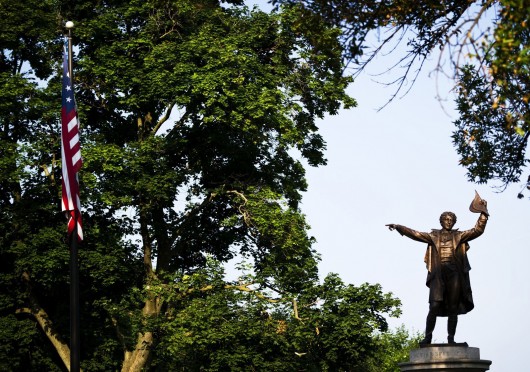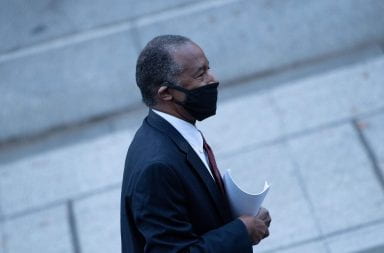
A statue of Francis Scott Key points to the American flag from atop a monument in Mount Olivet Cemetery in Frederick, Md. The writer of ‘The Star Spangled Banner’ wanted to be buried in Frederick, and his body was moved there from its original resting place at Old St. Paul’s Church in Baltimore. Key died in 1843 at the age of 63.
Credit: Courtesy of MCT
The Star-Spangled Banner turned 200 this month, and it remains one of the most recognizable aspects of this nation. It’s hard for me to remember a time when I didn’t know the words — it’s that ingrained within my mind and throughout our national culture.
I’d consider myself a patriotic person. I might be in the minority, but I still see the United States as a symbol of something that’s worth singing about. Many people’s opinion of our current political climate — mine included — is fairly negative, but that doesn’t necessarily make me dishonored with our country as a whole.
I guess what I’m trying to say is: I love America.
Which is why I was surprised when, until recently, I hadn’t even noticed a key part of the national anthem’s structure.
This newfound understanding came about after I watched arguably the anthem’s greatest rendition: Marvin Gaye at the 1983 NBA All-Star game. Instead of a brass band recording, Gaye was accompanied by only a simple beat, allowing his trademark soul to deliver 19th century thoughts squarely into the 20th century. By the last two lines, Gaye had the entire crowd at The Forum in his palms, and he appropriately raised them as the applause drowned out all other noise.
Just like in Gaye’s rendition, every time you’ve heard the Star-Spangled Banner, there was probably some pride involved. It’s sung before America’s most bombastic occasion, the Super Bowl, and if those performances aren’t triumphant, I don’t know what is.
That tone matches well with the circumstances of the song’s inception. Francis Scott Key began to write the words when he was amazed to find the flag still hung over Fort McHenry after two days of British naval bombardment; its mere presence was a sign that things were going to be okay.
And ever since then, we’ve been reciting his words. When we sit at a baseball game and stare at the pole in center field, it’s effectively the same version of Old Glory that Key saw fluttering in the September morning sky. The flag is also principally a symbol of the nation: when things look grim, it stands tall. It remains. It flies.
That’s really what the anthem does best: impose the identity of our nationality into one piece of fabric. I never realized a song could have that kind of power.
But what Gaye’s demeanor and magnetism revealed in his rendition of the Star-Spangled Banner is what makes it such an enduring and stirring anthem: it asks a question.
The last line of the song might give Americans their two favorite epithets, but the song isn’t saying those are still true to this day. Instead, Key’s words are — unbeknownst to him — reminding us of what the United States strives to be, and in so doing, reminding us of our responsibility to make it so.
It seems like Gaye understood that fact when he decided to put his own spin on the song. His hands are raised at the end because he’s asking all of those around him, and everyone watching on television, that very question.
Questions are easy to spot on paper, but they are a bit harder to decipher when spoken. The telltale sign of inquisition is inflection, like, for instance, the change in tone when a question mark is added to the end of an anchorman’s teleprompter. Just one character can make a huge difference.
Most examples of the anthem being sung — Whitney Houston’s memorable tour de force before the 1991 Super Bowl especially — don’t really exhibit any doubt per se.
But in fact, they do inquire.
That’s why I get so emotional when I hear it played. We live in a great country, but it can’t stay that way with complacency. Our exceptionality isn’t misguided, but it can only ring true after so long. When we believe everything is fine and dandy, that’s when we have problems. Inward reflection shouldn’t seem unpatriotic — it should be encouraged.
As long as we keep saying America is the greatest country in the world without contemporary examples to justify the claim, our go-to moniker travels further and further from the truth. But we have so much to offer as a people, so much more we can do than just sit on our laurels.
So today, tomorrow, before the first game of this year’s World Series, before the memorials on Veterans Day, as we struggle to match pitch to the 200-year-old song, remember what we’re ultimately asking ourselves.
“O say does that star-spangled banner yet wave, o’er the land of the free and the home of the brave?”


